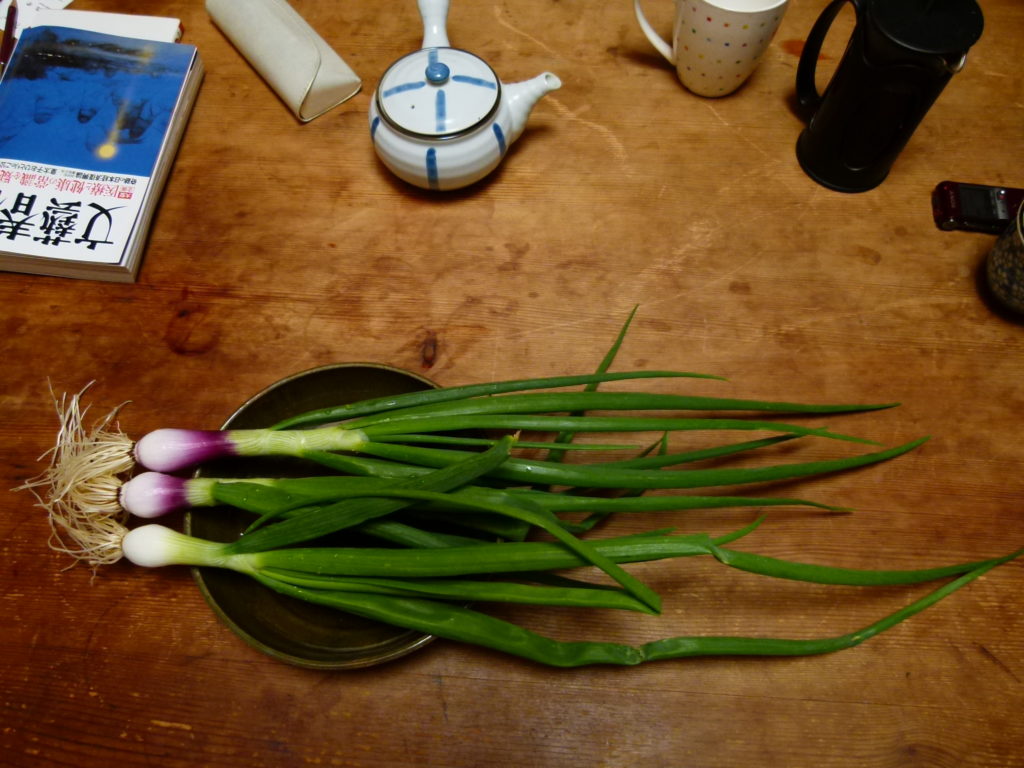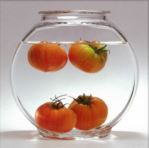Growing Delicious Vegetables in Japan
CONTENTS
How to grow delicious Japanese vegetables?
Strengthening Produce with Unfavorable Conditions
An old man sits alone by the open French windows on the south side of his room. Before him is a view of a garden bathed in bountiful sunlight. Hearing this, you may well think that this is a man who is whiling away his days in peace and comfort after a lifetime of hard work. But in the case of Terukichi Nagata, who turns 87 this year, you would be quite mistaken. He is not simply admiring the view of his garden, but watching carefully over each and every one of the things planted there.

In the garden, surrounded by blooms, vegetables and flowering plants are planted in orderly fashion. Although it looks like a kitchen garden at first glance, this garden is actually an experimental farm that has produced many patents. Upon closer inspection, there are rows of plants that are unfamiliar sights in ordinary garden plots: olive trees, figs, baby onions, turmeric, and mange tout to name but a few. What’s more, they are all planted in raised ridges of dried out red soil.
“This red soil,” Nagata says, “is the same as that in the third world, places such as Africa. If you’re talking about Asia, it’s the same as the soil in countries like India, Thailand, and Myanmar. Even today, it’s said that these countries can’t take off economically because they have low rates of agricultural productivity. But if you ask me, this soil, barren and said to be of the poorest quality, is precisely why you can grow the finest vegetables,” Nagata explains in a slow drawl, a smile spreading across his face.
The general way of thinking is that soil needs to be rich and fertile in order to grow things. Nagata turns this idea completely on its head. What’s more, he makes every effort to avoid giving plants water or fertilizer. That is the basis of the “Nagata Farming Method” that he established some 30 years ago.
Crops planted in soil with no nutrition assume a kind of starvation state, which makes them work harder to obtain only the necessary sustenance and water by absorbing it via their roots. This makes the plants stronger and produces fruit and vegetables that have high nutritional value and that keep their inherent fragrance and taste.
“Not giving water to the plant until the leaves wilt. Once they wilt, then you can give it some water. However,” Nagata laughs, “if you try that with plants raised in the usual way, they stay wilted and just wither away. They don’t have the same survival capability.”
That is why the Nagata method is also known as the “Spartan Farming Method” or “Fasting Farming Method.”
The World’s Best Onions Grown by Fishermen’s Wives
Nagata’s office is on the corner of a residential street, 20 minutes’ drive north of JR Hamamatsu station. The aforementioned garden next to this small single-story building, which also doubles up as Nagata’s home, is where Nagata has based his activities over the past 30 years. He also receives requests from people who wish to raise plants by the Nagata method, and travels out to locations not just within Japan, but also Asia, Europe, and even Africa. Nagata has mainly stayed in Hamamatsu this year as he is recovering from a heart operation, but until last year, he spent about half of each month away from home.
乾ききった永田さんの畑で元気に育つ葉タマネギ-1024x768.jpg)
“I don’t just teach people, I show them by doing it myself. That’s why my hands have grown so big!” Nagata explains, showing his hands as he does so. Compared to his small frame, they are indeed large and heavy. They are the hands that Nagata used to put into practice what had been a personal theory for a long time.
Nagata raises the plants in his experimental farm by largely by himself, receiving some help from his “students” Yutaka and Yukari Itagaki, a married couple who take care of his day-to-day needs. The olive tree, for example, was something he raised himself from a seed from Ushimado in Okayama Prefecture, where he has taught agriculture for a long time. The okra that he plans to plant in the garden shortly is the same plant that he taught how to cultivate in Sri Lanka, where he was invited as a state guest by the Sri Lankan President.

“In India,” Nagata adds, “they said they no longer have any turmeric of the quality I have here, so people from India come all the way over to study it.”
Nagata has been teaching how to cultivate onions, another of the plants he grows in his experimental farm, for around 20 years. Every time Nagata is invited to teach in Tosashimizu City in Kochi Prefecture, his presence is announced in a leaflet in the local newspaper. Those who come to see him teach are mostly the wives of local fishermen.
“The onions from Muai Island in Hawaii are said to be the most delicious in the world. On a sugar level meter, they measure about eight. The onions grown in Tosashimizu, however, score 12 – and that is why they are the world’s best onions. Ordinary people in Tosashimizu are growing and eating ingredients that are full of life. That is the biggest objective of what I teach.”
These days, there are over 100 people in Tosashimizu who grow onions using the Nagata method. Using the same method, they also grow other produce there such as pineapples, camellia (for oil), and Koshihikari rice.
Farmers in the Yoshikawa Ward of Joetsu City in Niigata Prefecture also employ the Nagata method to cultivate rice on a large scale. Close to 30 years ago, Nagata visited the area and walked around inspecting the fields. He proposed that fields using organic fertilizer should be burned into ash. Although stubble burning releases carbon dioxide gas, it only produces 1/20th of the greenhouse effect of the methane gas that organic material releases as it decomposes. In other words, Nagata’s outlook is that organic fertilizer is bad for the environment, and that it would be best for the environment if fields using organic fertilizer methods were burned into ash instead.
After local farmers had agreed to Nagata’s proposal and burned their fields, they started work on cultivating “Yamada Nishiki,” which is said to be the finest rice variety for sake (Japanese rice wine). At the time, it was thought that growing Yamada Nishiki in Niigata or the Tohoku region wasn’t possible because those areas have short hours of sunlight per day from October onwards. However, under Nagata’s tutelage, the crop was a success in its very first year. After that, farmers in Yoshikawa started growing Koshihikari rice using the same method. The rice they grew sizably outperformed rice from Uonuma, also in Niigata Prefecture and famous as a rice brand, in terms of “shokumi,” which is a scale used to measure the deliciousness of rice. Continuing in the same vein, Yoshikawa attained the international environmental standard ISO14001 in 2000. At the time, it was the first place to attain that standard for its agriculture.
“Usually, if you poll residents on environmental problems, there will always be one or two who say they ‘don’t like the sound’ of what you’re proposing and oppose it,” Nagata laughs, “But in Yoshikawa, no-one did. I think that’s because up until then I had been teaching there for over 10 years or so, and since ‘that’s the way Nagata does it,’ they agreed to it.”
The Secret of Deliciousness Is to Grow “The Real Thing”
There are countless numbers of people, from Hokkaido to Miyako Island in Okinawa, who have grown crops after being taught directly by Nagata himself. These people send Nagata fresh ingredients in peak season from all over Japan. On the day of this interview, Ms. Itagaki had prepared a feast using fruit and vegetables grown by the Nakata method, including those they had received from elsewhere in Japan. The rice was wholegrain rice from the aforementioned Yoshikawa. There were side-dishes of field peas, fermented soy beans with chopped baby onion leaves, and soy milk soup. The dessert was kumquats that Nagata had picked himself broiled in syrup. To drink, there was chamomile tea and Ureshino tea from Saga Prefecture. Common to all the vegetables was a sweetness that spread out in the mouth after chewing. Evaluating the rice was a little difficult for someone not used to eating wholegrain rice, but one thing that was discernible was its sweetness. Incidentally, boiling and squeezing green soy beans and drinking the resulting soy milk is part of Nagata’s daily morning routine.
As these “Nagata vegetables,” which use the minimum amount of fertilizer and agrochemicals, are so delicious, it would be a surprise if professional chefs weren’t interested in using them. One December morning, Nagata visited a famous high-class Japanese restaurant in Kyoto bringing with him pumpkins that had been grown on a farm in Hokkaido. Fifty active proprietors of Kyoto cuisine restaurants gathered there to taste them, which rated 20 on the sweetness scale. They were delighted with the taste, with one remarking, “It’s been a long time since I tasted a pumpkin that hadn’t been broiled in sweet broth, but yet as sweet as this.”
On another occasion, a manager of a different Kyoto restaurant came to one of Nagata’s other garden plots in Hamamatsu City for a study trip with his entourage of 60 staff. There, they sampled some small unwashed carrots, and everyone was impressed with the deliciousness and fragrance of this ingredient.
Three chefs from three-star French restaurants have also made the journey all the way to Nagata’s plot. Regardless of the country or genre of cuisine, chefs of famous restaurants identify with Nagata, and are regular users of vegetables grown using his method.
As the cultivation method is different, likewise the crops produced by it are different to what we are used to. For example, we tend to imagine that the redder the tomato, the sweeter the taste. But the color of Nagata’s tomatoes is closer to orange. On the surface of those tomatoes sprout white downy hairs that attempt to absorb even the tiniest amount of moisture from the air. In addition, as these tomatoes are packed with pulp, even small ones feel weighty on the palm, and if you put them in water, they almost all sink. Nagata’s onions don’t release the strong vapors when cut with a knife, so they don’t make you cry. His egg plants don’t taste astringent even when eaten raw, so they can be eaten as a salad. The same is true for his spinach. Another characteristic of Nagata vegetables is that they can be eaten whole or close to whole. For example, mikan oranges can be eaten without peeling, broad beans can be eaten without taking them out of their pod, while pineapples can be eaten right down to their wicks.
“I’m often asked, ‘What’s the secret of deliciousness?’ Well, in short,” Nagata concludes, “you just need to grow the ‘real thing’.” A lot of people work hard to try and grow the real thing, and occasionally they go to great lengths and end up doing things that are harmful for their bodies. But Nagata’s way of growing vegetables is actually very simple: if you leave it up to the plants’ inherent abilities, the resulting vegetables will surely be both delicious and good for you.
The Success of “Pebble Cultivation” and Validating Chemical Fertilizer
Nagata was born on an outlying island in Amakusa, Kumamoto Prefecture, in 1926. His father lived separately in Kumamoto City as he had a job at Kumamoto Prefectural Office, and so Nagata was raised by his grandparents in Amakusa until the age of 10. His grandfather was a large landowner and took the young Nagata with him as he walked around various parts of his estate. This period of interacting with vegetables, fruits, and other vegetation, was the start-point of Nagata’s later life as an agricultural researcher. Here, Nagata also learned that the same type of plant had a different flavor if the place where it grew was different.

Nagata graduated from Seiseiko high school, the leading preparatory school in the prefecture, before entering Kobe Commercial College (now Kobe University Faculty of Economics). The reason Nagata majored in economics was because he had a dream that at some point he would travel to Brazil and farm there. However, circumstances changed with the death of his father and the agricultural land reforms that were underway at that time. Persons who died without a successor could be declared “absent” landowners and have their land confiscated, so Nagata’s mother pleaded with him as the oldest son of the family to remain in his hometown.
The youthful Nagata put serious effort into farming in a bid to realize his Amazonian dream at home in Amakusa. However, he had absolutely no agricultural experience and didn’t know where to start. To make matters worse, his farmland was terraced fields on the side of a rocky mountain. He trusted his instincts and started to grow citrus fruits such as tangerines as well as various vegetables. The fertilizer he used at the time was made via a process of trial and error by diluting human waste with water or sea water.

Eventually, Nagata realized something surprising. The vegetables and mikan oranges grown on fertile level land didn’t taste anywhere near as good as the ones grown on rough, rocky ground. Nagata was puzzled by this gap between what was written in the farming books he had started to read at that time, and the reality in front of him. In the end, Nagata decided to trust what he saw and tasted with his own eyes and tongue.
“I hadn’t received any prior agricultural education,” Nagata recalls, “but I think that’s the reason why I was able to take what I saw before me at face value.”
Just at that time, Eiji Fukushima, a lecturer at Kyushu University and originator of “sand cultivation,” visited Nagata’s farmland. Fukushima noted the similarities between his own sand cultivation and Nagata’s “pebble cultivation” and helped develop the theoretical basis of Nagata’s farming method. Fukushima also gave Nagata liquid chemical fertilizer made from “nitrogen,” “phosphorous,” and “potassium,” and asked him to test whether it was possible to grow crops using just that liquid without using organic fertilizers.
Nagata took this on and continued to grow mikan on his pebble-strewn land for the next 10 years. With that, extremely sweet mikan would fruit every year, rating 16-17 on the sweetness scale. What’s more, they grew three times as fast as those grown on land with compost ploughed into it. The plants did not develop any sort of diseases either, which proved to Nagata the hypothesis that just three elements – nitrogen, phosphorous, and potassium – are sufficient to cultivate plants. Nagata started to use that liquid fertilizer thereafter, and he continues to use it today over 50 years later.
There are many farmers who are struggling with the damaged caused by the nuclear incident in Fukushima Prefecture, including farmers in Shinchi Town in the Soma district where Nagata used to teach. The current situation that surrounds Japanese agriculture is harsh. On the other hand, however, there are examples like Tosashimizu where farming is being changed by the citizens’ own efforts.
Nagata’s will to put his vegetable growing method on the line continues to burn. In October this year, he will head out to Tanzania, where Sumitomo Chemical Company has established a large factory producing mosquito nets to prevent malaria. There, he will teach how to cultivate vegetables that will be used in the factory canteen, which serves over 6,000 employees. All of those vegetables are also slated to be sold to famous restaurants in Paris.
“The view I see from here,” Nagata says, looking fondly at the garden outside his window, “This is real farming, isn’t it?”
Today, like every day, Nagata is contemplating vegetable growing both domestically and internationally via the garden that stretches out in front of him.


